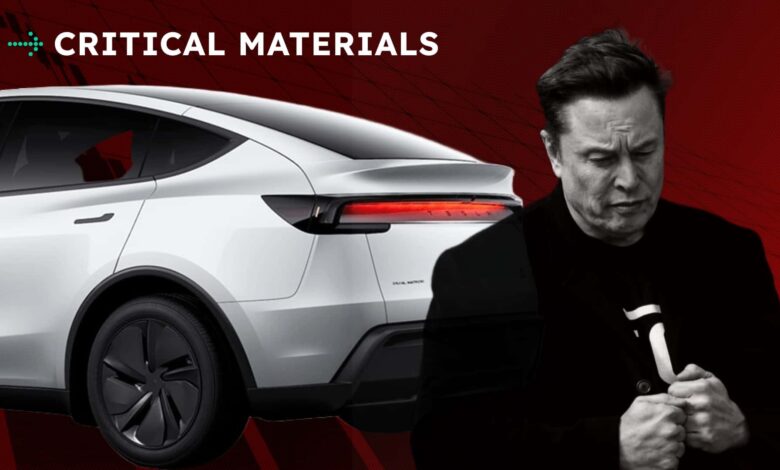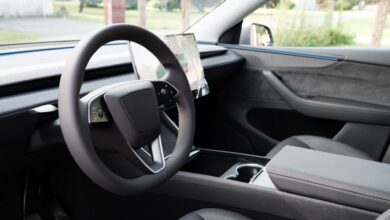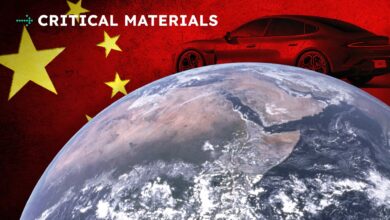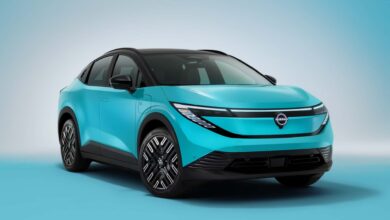Tesla In ’Panic Mode’ After Report Of New CEO Search

Elon this, Elon that. It’s never a dull moment in Tesla land when its polarizing CEO is on the front page of the internet. But this time, it’s for something that nobody thought possible: rumors that the board began searching to replace the company figurehead.
Welcome back to Critical Materials, your daily roundup for all things electric and tech in the automotive space. Today, Tesla is in the news (again) over Musk—this time, over a rumored attempt to replace the CEO that was immediately refuted by both Musk and Tesla.
We’ve also got word that Ford has axed a key next-gen zonal architecture project, plus more uncertainty in the tariff department. Let’s jump in.
30%: WSJ Reports Tesla Board Considered New CEO Search

Photo by: YouTube
While CEO Elon Musk was nose-deep in Washington, Tesla began to suffer. Sales declined, brand image turned toxic and Tesla’s revenue fell a whopping 71% year-over-year. Trouble was brewing in Tesla’s so-called ”ecological paradise,” and it finally caused Tesla’s board to grow a spine—or so says a report from the Wall Street Journal that Tesla (and Musk) has vehemently denied.
Tesla’s board has been criticized for pretty much letting Musk run the show. Despite being ousted from his post as board chair in 2018 following a settlement with the U.S. Securities and Exchange Commission, the world still very much felt like Musk was running the show. Government officials even recently called on the board publicly to do their job and rein in their CEO after the company started suffering financially while Musk spent his time in politics.
Apparently, all of the criticism must have hit home, because the WSJ reports that Tesla’s board took it upon themselves to launch a search for a new CEO while Musk spent his time 1,600 miles away on Pennsylvania Avenue.
Let’s get into the thick of it directly from the story:
About a month ago, with Tesla’s stock sinking and some investors irritated about Elon Musk’s White House focus, Tesla’s board got serious about looking for Musk’s successor. Board members reached out to several executive search firms to work on a formal process for finding Tesla’s next chief executive, according to people familiar with the discussions.
[…]
Around that time, Tesla’s board met with Musk for an update. Board members told him he needed to spend more time on Tesla, according to people familiar with the meeting. And he needed to say so publicly. Musk didn’t push back.
If that last line sounds familiar, you were probably tuned into Musk’s long-winded political rant during the company’s latest quarterly earnings call. Musk signed off his introduction by affirming that he planned to spend more time at Tesla. At least 60% more time, but no more than 80%. In his own words, Musk said that he would reduce his time to ”a day or two per week on government matters.”
Too little, too late, though, as the board had reportedly already begun the search with an executive recruiting firm. In case you weren’t familiar with these specific types of agencies, they’re some serious headhunters meant to seek out top executive talent across the globe. And Musk’s shoes? As tarnished as they may seem to the outside world, they’re big ones to fill. So while Musk was cosplaying as DOGE’s Secretary of Whatever, Tesla’s board quietly reached out to one of these firms to get the ball rolling and find someone who could steer the AI and robotaxi ship safely back to port.
Maybe that got Musk’s attention, because his clear announcement of spending more time at Tesla was certainly heard by investors. More from the WSJ:
The board narrowed its focus to a major search firm, according to the people familiar with the discussions. The current status of the succession planning couldn’t be determined. It is also unclear if Musk, himself a Tesla board member, was aware of the effort, or if his pledge to spend more time at Tesla has affected succession planning. Musk didn’t respond to requests for comment.
During a cabinet meeting on Wednesday, Trump thanked Musk for his government work. “You know you’re invited to stay as long as you want,” Trump said. “I guess he wants to get back home to his cars.”
Now, it’s important to be abundantly clear here, just in case you missed it above: WSJ’s reporting says that whether or not Tesla is still looking for a replacement for Musk is unknown. How far they got into the search or if they’re continuing down that path isn’t clear.
Following the report, Tesla has been on a warpath to dispel it entirely.
Both Musk and Tesla posted on his X just before 2 a.m. EST on Monday to write off the rumors. Tesla’s statement included words from the board chairwoman, Robin Denholm, stating that the report was ”absolutely false” and that claim had been communicated to WSJ before the report was published. The statement went on to say that Tesla is ”highly confident” in Musk’s ability to ”continue executing [Tesla’s] growth plan.”
Musk called the report an ”extremely bad breach of ethics,” and said that the Tesla Board of Directors provided an ”unequivocal denial” ahead of time.
Tesla and Musk haven’t exactly had the best track record with public denials of rumors holding up over time. For instance, when a report surfaced that Tesla’s $25,000 car based on the Cybercab was dead, Musk said that Reuters (which originally published the article) was lying.
Musk later said that the company wouldn’t produce a $25,000 car that wasn’t a robotaxi, followed by a note from Tesla’s VP of Engineering, Lars Moravy, that the company’s cheaper EV would be one of its existing products—likely the Model 3 and/or Model Y—”in form and shape.” The automaker also denied rumors that Tesla would begin trialing out its Full Self-Driving software in China, only to begin rollout a few months later.
Even so, it’s hard to ignore that Tesla has some rather funky stuff going on in the leadership chain recently that has raised eyebrows.
Ahead of the WSJ report came news of the departure of Vineet Mehta, Tesla’s long-time head of battery architecture. Mehta has been with Tesla for 17 years (he joined in 2007 before Tesla even launched the first-gen Roadster) and was identified as a potential successor for Musk back in 2022 (alongside Drew Baglino and JB Straubel, both of whom have now left Tesla) by one investment firm.
Then there’s Robin Denholm, the company’s chairwoman. Critics have noticed that Denholm has been offloading Tesla shares like it’s her job lately. In fact, over the last decade, she’s pocketed more than $600 in stock compensation and has now liquidated most of the remaining portion of her Tesla shares, according to a filing with the SEC on Tuesday. There’s no official word that Denholm is out at Tesla, but it’s got to be a bit disheartening to be a Tesla employee and be told by your boss not to sell your stock, only to see the board offloading millions of dollars worth.
Coincidence? Maybe. But the timing of the sale isn’t great, and the general vibe at Tesla just feels…off. Think of it this way: if you’re an investor and you see the person in charge of oversight appearing to pull the ripcord right before news of a high-level departure broke, what might you think?
60%: Ford Just Axed Its Next-Gen EV Brain Project

Photo by: InsideEVs
Ford reportedly just pulled the plug on a project called FNV4, its so-called ”fully networked vehicle” project. No, this wasn’t some new car, but something much more deep-rooted: a next-gen zonal architecture meant to underpin new vehicle platforms across the board, regardless of the powertrain under the hood.
According to a report from Reuters, Ford has officially scrapped FNV4 and is now back to a blank slate. And what does the brand have to show for it? Well, it might as well be a trunk full of spaghetti code and so-called ”copper anacondas.”
Reuters has the juicy details of what happened to FNV4:
Ford Motor Co. has killed a program to develop next-generation electrical architecture – the brain of modern cars – that its executives have called pivotal to competing with electric-vehicle pioneers such as Tesla, three sources familiar with the matter told Reuters.
Ford had invested heavily in the system, known internally as FNV4 (for fully-networked vehicle), to streamline vehicle-software functions. The goal was to cut costs, improve quality and add profitable features in both electric and gasoline-powered vehicles.
The project was abandoned because of ballooning costs and delays, the sources said.
A Ford spokesperson said the company will absorb what it learned from developing FNV4 into its current software system, and it remains focused on delivering an advanced electrical architecture with its so-called skunkworks team.
Terry Woychowski, the president at the engineering firm Caresoft Global, says that these copper anacondas are the reality that legacy automakers are dealing with today—basically huge lumps of wiring harnesses that aren’t intuitive compared to elegant zonal architectures being developed by more modern automakers like Rivian. FNV4 was Ford’s chance at modernizing the software underpinnings of Ford’s next-gen cars, plus it could slash both wiring-related and assembly costs. Another advantage? Speedier over-the-air updates to customers.
The plans to scrap the project were leaked as early as last Friday on The Layoff, a forum where folks who claim to be employees at corporations can anonymously (but publicly) discuss company happenings. One employee estimates that Ford sunk between $10 billion and $15 billion into the project—a number that aligns with Ford’s $9.7 billion in EV-related losses in 2023 and 2024. Many others point their fingers at Doug Field, a former Tesla and Apple brainiac poached by Ford to work on its EV projects back in 2021.
Other employees claim that Ford moved some of its resources to CE1, the company’s ongoing project to build a dedicated low-cost EV platform, which is in line with Ford’s statement that it would absorb the lessons learned from FNV4 into its current software and continue working towards an ”advanced electrical architecture.”
FNV4’s death means that Ford might not have a clean path forward for the software-defined car. Woychowski says that’s a problem, because speed is the ”only strategic advantage” that any company can have. And with Ford behind the eight ball on Software-Defined Vehicles already, a fresh start could mean being years behind.
90%: Automakers Are Scrapping Financial Predictions As Tariff Uncertainty Continues

Photo by: InsideEVs
There’s a panic at the car disco and the DJ’s name is Donald. Automakers are in full-on freakout mode as the Trump administration continues to yo-yo the threat of tariffs, making it next to impossible to make long-term business plans and projections.
Many major automakers are now withdrawing their financial guidance and projections following Trump’s rally, where he not only boasted about his first 100 days in office, but also announced that his cabinet’s policy on automotive tariffs would (once again) change shape. Instead of confidently touting a positive position and outlook on business, manufacturers are ripping up their forecasts and throwing their hands in the air.
The change led automakers like General Motors, Mercedes-Benz, Stellantis, Volkswagen, and Volvo to toss their respective financial outlooks into the circular filing cabinet. The culprit? Tariffs, of course.
Here’s a snippet from Automotive News discussing Stellantis and Mercedes-Benz doing exactly that:
President Donald Trump’s tariffs prompted several of Europe’s largest automakers to withdraw financial guidance, underlining the extent of the chaos unleashed by his fast-changing trade tactics.
Stellantis, Mercedes-Benz and Polestar on April 30 pulled their forecasts for this year citing the duties, which are upending supply chains and driving up car prices.
The volatility sparked by the duties “is too high to reliably assess” how business will develop this year, Mercedes said. The automaker warned that operating earnings, cash flow and margins would be hit if the current trade hurdles persist.
They’re not alone, either. To be clear, this latest round of automakers withdrawing their financial projects isn’t the first of the year, or even the quarter. Volkswagen’s earnings projections, for example, included a specific note that its outlook excluded the impact of U.S. tariffs. GM and Volvo had also pulled their guidance following the issuance of their first-quarter earnings.
This isn’t even a problem unique to the auto industry, according to Reuters. The agency says that more than 40 companies worldwide have all pulled, lowered, or otherwise excluded financial predictions in recent weeks over U.S. trade policies creating rippling turmoil in the global markets.
CEOs have said that the tariffs have caused ”chaos” across the industry in the past, but as the situation somehow becomes the norm, automakers are now finding ways to make the situation seem a bit lighter than they really are. For example, Mercedes called the situation a ”dynamic market involvement,” which is kind of akin to calling a tornado a breeze with a personality.
In reality, these tariffs are an ongoing issue that have yet to truly materialize at the consumer’s pocket when they show up at a car dealership. Many automakers have temporarily frozen prices by eating costs or stockpiling as many vehicles and parts as possible on U.S. shores ahead of major hikes. But in the coming months, without any major tariff reforms or revocations, consumers and businesses, regardless of size, will be impacted.
How much? Well, that’s still being worked out and could even be subject to change at any given moment, which is why it’s so hard for these brands to accurately forecast how their year is going to shape out.
100%: Who Would Lead Tesla If Musk Moved On?

Photo by: InsideEVs
Tesla’s brand image hasn’t been the most healthy lately. At the core of its problems is ”changing political sentiment,” according to the company’s latest earnings report, which is a fancy way of saying that the public isn’t really feeling the political activism that the company’s CEO is involved in.
But a 71% YOY drop in revenue is nothing to shake a stick at, especially as competition in the market is steadily increasing across the globe. And if you’ve got the entire world criticizing how your company’s leadership is running the government—while they’re supposed to be steering the corporate ship— then there’s probably a deeper issue that needs to be addressed.
So if Tesla moved on from Elon Musk, who, in your mind, should be tapped to do that? Sound off in the comments.



